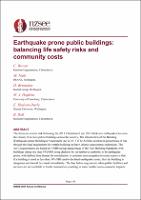Earthquake prone public buildings: balancing life safety risks and community costs

Download
Date
2021-04-14Authors
Brown, Charlotte
Nuth, Michael
Brunsdon, Dave
Hopkins, W John
Hudson-Doyle, Emma
Ball, Richard
Metadata
Show full item recordAbstract
The focus on seismic risk following the 2011 Christchurch and 2016 Kaikoura earthquakes has seen the closure of several public buildings across the country. The introduction of the Building (Earthquake-prone Buildings) Amendment Act in 2016 (The Act) has reinforced perceptions of risk through the legal requirement for certain buildings to have seismic assessments undertaken. The Act’s requirements are based on %NBS ratings (percentage of the New Building Standard), with buildings rating less than 34%NBS being declared by the territorial authority to be earthquake prone, with defined time frames for remediation. A common misconception in some sectors is that if a building is rated as less than 34%NBS and/or declared earthquake-prone, then the building is dangerous and should be closed immediately. This has led to long periods when public facilities and services are not available to local communities, resulting in some notable socio-economic impacts.
There appears to be inconsistency in how territorial authorities, acting as public building owners, are approaching this challenge: some councils rapidly close buildings (even prior to earthquake prone decisions being made) and others keeping buildings with lower seismic ratings open. This project explores 1) legal obligations on territorial authorities around earthquake prone buildings; 2) processes territorial authorities currently use to make decisions around the closure of buildings categorised as earthquake prone; and 3) a potential approach to better balance the immediate and direct socio-economic impacts of building closure against the possible physical and human impacts of an event that occurs on a geological time scale.
